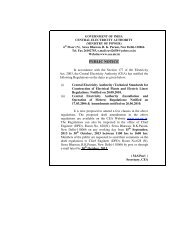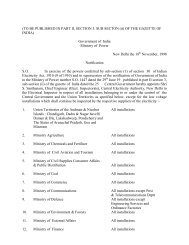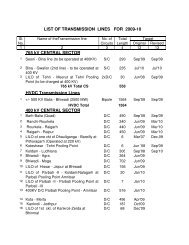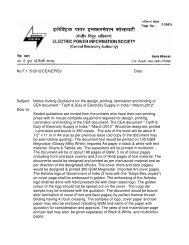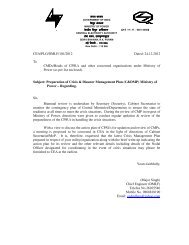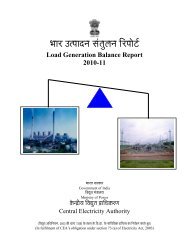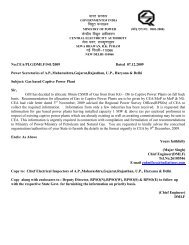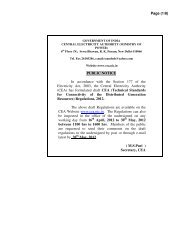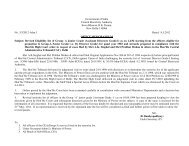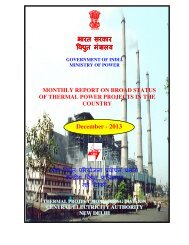Additional suggestions on indian electricity grid code proposed to be ...
Additional suggestions on indian electricity grid code proposed to be ...
Additional suggestions on indian electricity grid code proposed to be ...
Create successful ePaper yourself
Turn your PDF publications into a flip-book with our unique Google optimized e-Paper software.
7. Clause 6.4 (21)The meters used at interc<strong>on</strong>necti<strong>on</strong>s are termed as “interface meters” inCentral Electricity Authority (installati<strong>on</strong> and operati<strong>on</strong> of meters)Regulati<strong>on</strong>s, 2006. Accordingly, term ‘special energy meters’ used in thisclause and wherever appearing in the <strong>proposed</strong> IEGC should <strong>be</strong> replacedby the term “interface meters”. It may <strong>be</strong> pointed out that UI regulati<strong>on</strong>sissued by CERC already used the term interface meters.8. Clause 6.4 (28)Commercial implicati<strong>on</strong>s of inter-regi<strong>on</strong>al exchanges of power getreflected in the REA, UI accounts and Reactive Energy account preparedby RPC Secretariat c<strong>on</strong>cerned. Therefore, it appears that intenti<strong>on</strong> in the<strong>proposed</strong> IEGC is that NLDC should maintain statistics of inter-regi<strong>on</strong>alexchanges of power. If so, the provisi<strong>on</strong> regarding energy accountingmay <strong>be</strong> reworded appropriately.9. Clause 6.5 (19)It is noted that in the UI regulati<strong>on</strong>s, a limit has <strong>be</strong>en put <strong>on</strong> under injecti<strong>on</strong>by the genera<strong>to</strong>r. To do so, the genera<strong>to</strong>rs must have facility <strong>to</strong> revisetheir declarati<strong>on</strong> in case of forced outages. However, this clause of<strong>proposed</strong> IEGC allows <strong>on</strong>ly genera<strong>to</strong>r with two part tariff and l<strong>on</strong>g termc<strong>on</strong>tract <strong>to</strong> revise their schedule in case of forced outage. Therefore <strong>to</strong>have a level playing field and <strong>to</strong> enable genera<strong>to</strong>rs <strong>to</strong> generate close <strong>to</strong>their schedule, genera<strong>to</strong>rs supplying through bilateral transacti<strong>on</strong>s underopen access should <strong>be</strong> given right <strong>to</strong> revise declarati<strong>on</strong> in case of forcedoutages. Since such events are not so comm<strong>on</strong> in a well maintainedgenerating stati<strong>on</strong>, a limit say <strong>on</strong>ce per day may also <strong>be</strong> specified for thispurpose.10. Clause 6.5 (23)Wind forecasting <strong>to</strong>ols are independent of the generating plant of the windfarms and therefore, there appears <strong>to</strong> <strong>be</strong> no technology related reas<strong>on</strong> forproposal <strong>to</strong> exempt wind farms for which PPAs have already <strong>be</strong>en signedfrom the requirement of wind forecasting. This exempti<strong>on</strong> appears <strong>to</strong> have<strong>be</strong>en made <strong>on</strong> the c<strong>on</strong>siderati<strong>on</strong> that it will upset existing commercialagreements. In this regard, it needs no emphasis that new regula<strong>to</strong>ryinitiatives can always override prevailing c<strong>on</strong>tracts, like when ABT wasimplemented it altered the agreed commercial arrangement <strong>be</strong>tweenexisting generating stati<strong>on</strong>s and their <strong>be</strong>neficiaries.5
Also, there appears <strong>to</strong> <strong>be</strong> ambiguity in the provisi<strong>on</strong>s regardingrevisi<strong>on</strong> of schedules due <strong>to</strong> two separate provisi<strong>on</strong>s- <strong>on</strong>e regardingeffectiveness of the revisi<strong>on</strong> from the sixth time block and the otherregarding scheduling <strong>on</strong> 3 hour time slot basis. It is suggested thatrevisi<strong>on</strong> of the schedule should <strong>be</strong> effective <strong>on</strong>ly from the <strong>be</strong>ginning ofnext 3 hour time slot, provided notice <strong>to</strong> this effect is given at least fourtime blocks in advance.12. Annexure I (Complimentary Commercial Mechanism)To bring in more clarity, it is suggested that Commercial Mechanismregarding renewable sources should <strong>be</strong> made part of a separateAnnexure.From para 1 and 2 of the Annexure, it appears that this mechanism isapplicable <strong>to</strong> ISGS <strong>on</strong>ly as no menti<strong>on</strong> has <strong>be</strong>en made about transacti<strong>on</strong>smade using access <strong>to</strong> ISTS. However, in para 4 regarding Renewablesources, it appears that these provisi<strong>on</strong>s are applicable <strong>to</strong> renewableISGS as well as <strong>to</strong> renewable energy sources supplying power usingaccess <strong>to</strong> ISTS. This aspect may <strong>be</strong> looked in<strong>to</strong> while finalizing the IEGC.From para 5, it appears that in some cases, Renewable Regula<strong>to</strong>rycharge would <strong>be</strong> payable while in some other cases, it would <strong>be</strong>receivable. Therefore, it is suggested that there should <strong>be</strong> a provisi<strong>on</strong> forcreati<strong>on</strong> of a Renewable Energy Charge pool <strong>on</strong> the lines of UI pool.Also, it is suggested that there is need <strong>to</strong> relook in<strong>to</strong> sharing of UIcharges <strong>be</strong>tween buying state and wind/solar genera<strong>to</strong>r particularly forover-injecti<strong>on</strong> exceeding 30%. In shortage c<strong>on</strong>diti<strong>on</strong>s, when frequencymay <strong>be</strong> low (and hence UI rate will <strong>be</strong> high), the <strong>proposed</strong> provisi<strong>on</strong> mayprovide perverted incentive for the wind/solar genera<strong>to</strong>r <strong>to</strong> under-declarecapability and get lower schedules. Thereafter, he may over-inject <strong>be</strong>y<strong>on</strong>dschedule in excess of 30% <strong>to</strong> earn undue m<strong>on</strong>ey. This is particularly truesince no check is <strong>proposed</strong> <strong>on</strong> the forecasting <strong>to</strong>ol of the wind/solargenera<strong>to</strong>r. One way out could <strong>be</strong> <strong>to</strong> specify the requirement for forecasting<strong>to</strong>ol that it will <strong>be</strong> free from manual interventi<strong>on</strong> and forecasting resultsshould <strong>be</strong> recorded in such a manner that they can not <strong>be</strong> tampered with.If such technological requirement is not feasible, the <strong>proposed</strong> commercialmechanism may <strong>be</strong> re-casted <strong>to</strong> avoid such gaming.In para 6, it is <strong>proposed</strong> that for wind/solar genera<strong>to</strong>rs, a maximumdeviati<strong>on</strong> of 50% will <strong>be</strong> allowed in a time block. However, c<strong>on</strong>sequencesof deviati<strong>on</strong>s <strong>be</strong>y<strong>on</strong>d 50% are not clear. Generally, <strong>grid</strong> security may <strong>be</strong>endangered <strong>on</strong>ly in case of over-injecti<strong>on</strong>. Such provisi<strong>on</strong>, withoutadditi<strong>on</strong>al financial implicati<strong>on</strong>s may not serve the desired purpose.6



